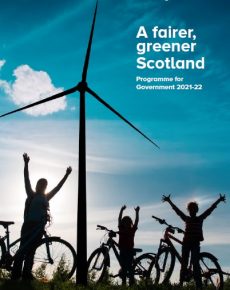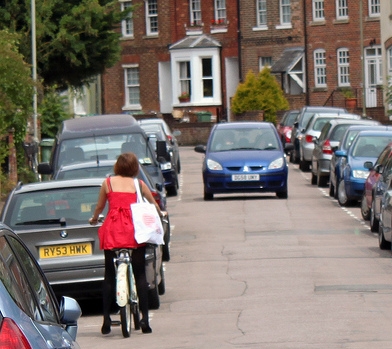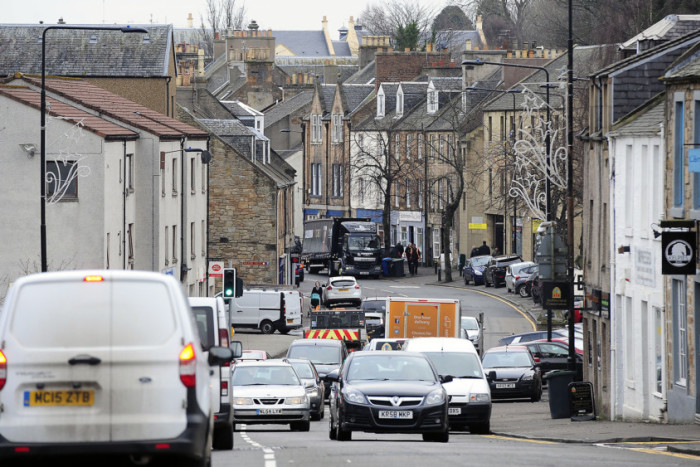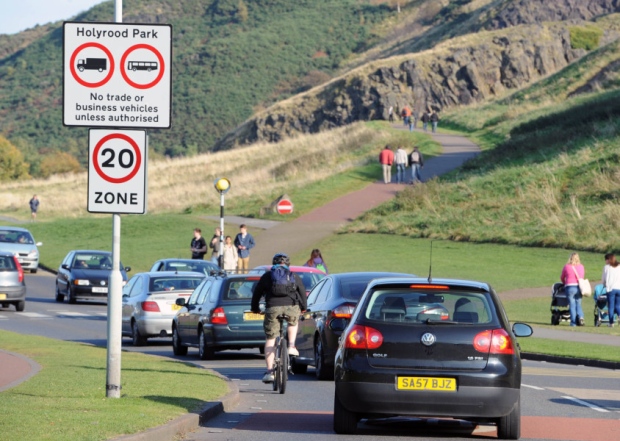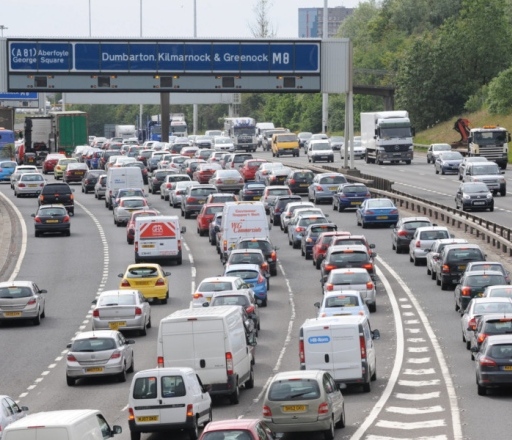The Programme for Government (PfG) largely confirms what we already know from the SNP/Green agreement and previous announcements, rather than anything new. The PfG policies do have potential for greatly increased active travel – but only if actions live up to policies, if serious obstacles are overcome and if contradictions are resolved.
More generally, there is growing concern that the PfG’s actions on the climate emergency do not match up to its policies and targets – including on transport – as in this excellent Scotsman article, this Transform Scotland twitter thread and this FOE response to the PfG.
Two policies in particular have the potential to transform active travel (AT) in Scotland – and both are essential.
- the huge promised increase in AT cash
- the target/promise to cut car-km by 20% by 2030
Both however will require work and determination to ensure full success and maximum benefit.
Several other PfG policies (summarised in Appendix 1 below) will also contribute to increased AT and will in turn benefit from the above – but again there will be the need for political courage and careful scrutiny to ensure success.
In the following sections we give relevant page numbers from the PfG pdf. For example, the next section refers to page 97]
1. Increased AT cash [PfG, p97]
As in the SNP/Green agreement, 10% of the Transport Budget (or a minimum of £320m) will be allocated to AT by 24/25 – compared to £115m in the current year, 21/22. This is potentially truly transformational.
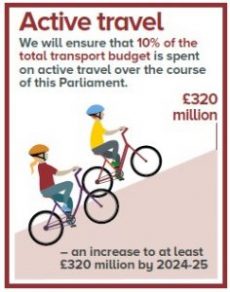
Scotland is already well ahead of England in AT funding, and the new cash will rise from roughly £20 per person per year at present to over £50 by 24/25. This is sufficient, if wisely used, to implement high quality infrastructure at a rate faster even than countries such as Netherlands and Denmark were able to do.
However, the PfG does not state how the increase will be phased over the next 3 budgets. In particular, we would hope for at least equal spacing of the increase over the 3 years, which would mean AT cash up from £115m in 21/22 to some £180m in the forthcoming 22/23 budget (the draft budget is expected in December). Nor is it clear from the PfG how the new cash will be used – although there are some hints – see Appendix 2 below.
Is cash everything?
It is tempting to think that cash will solve everything, but much else is needed to ensure that the cash is fully and effectively used. This requires political understanding, action and sometimes courage. The following bullet points outline 3 major obstacles which the Scottish Government and/or local councils need to address.
- Scotland’s Traffic Order regulations are a mess and can cause substantial delays (literally years) in AT projects, and big administrative burdens for Councils. Some of the problems are laid out in this recent Spokes submission. Such problems make budgeting more difficult and/or mean budgeted cash cannot be spent. Of course full public consultation on AT schemes is essential but, unlike England where the Traffic Order rules are much more straightforward, the Scottish Government’s rules are seriously dysfunctional. In case this sounds like exaggeration, we give some examples from Edinburgh in Appendix 3 below. The Scottish Government recognised the need to sort this in 2018 debates on the Transport Scotland Bill, and promised a review. That review is still not complete, and the problems for Councils such as Edinburgh have become even worse as they fight their way through the legalities of trying to make successful Spaces for People schemes permanent. Scottish Government action is long overdue.
- In order to construct high quality infrastructure, roadspace re-allocation is essential, particularly on major urban roads. Until the space is available, infrastructure cash cannot be spent to best effect. Representative opinion polls show majority support for roadspace reallocation, even amongst drivers. However, as in Edinburgh and many other cities, it often attracts vociferous opposition from a substantial minority, sufficient to deter some Councils entirely and to cause major delays in others – sometimes with legal battles ensuing. These political problems over roadspace reallocation would be greatly eased if the Scottish Government…
- acts seriously on its promise to reduce car-km, and
- amends Traffic Order regulations, more like in England
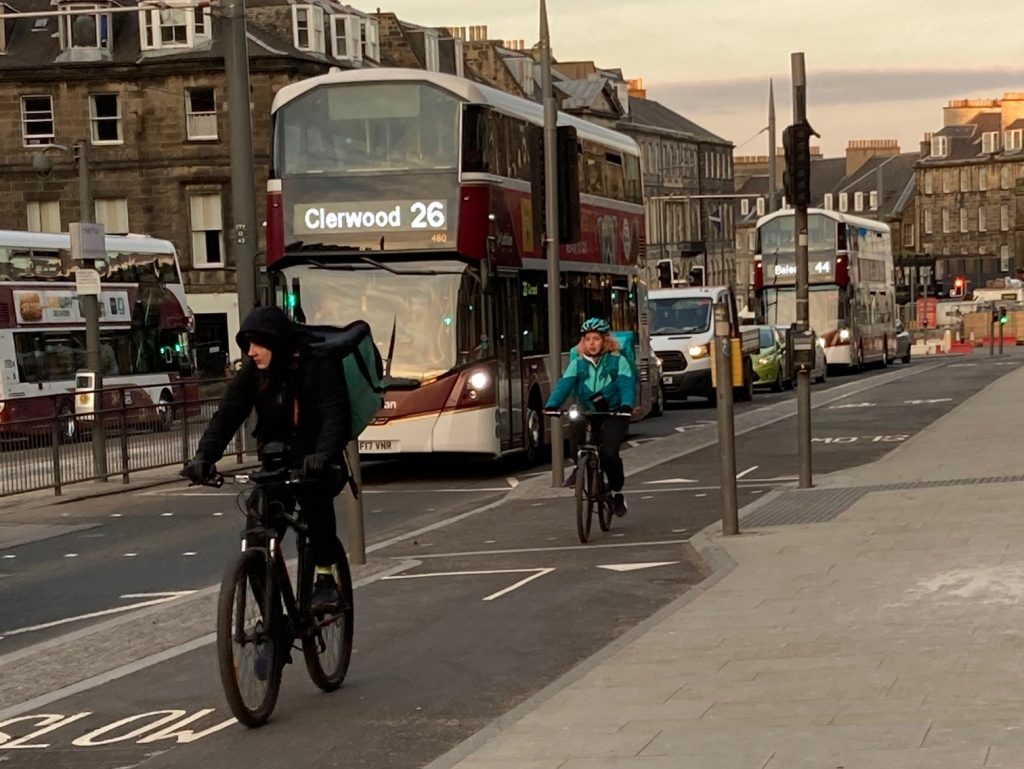
permanent cycle lane 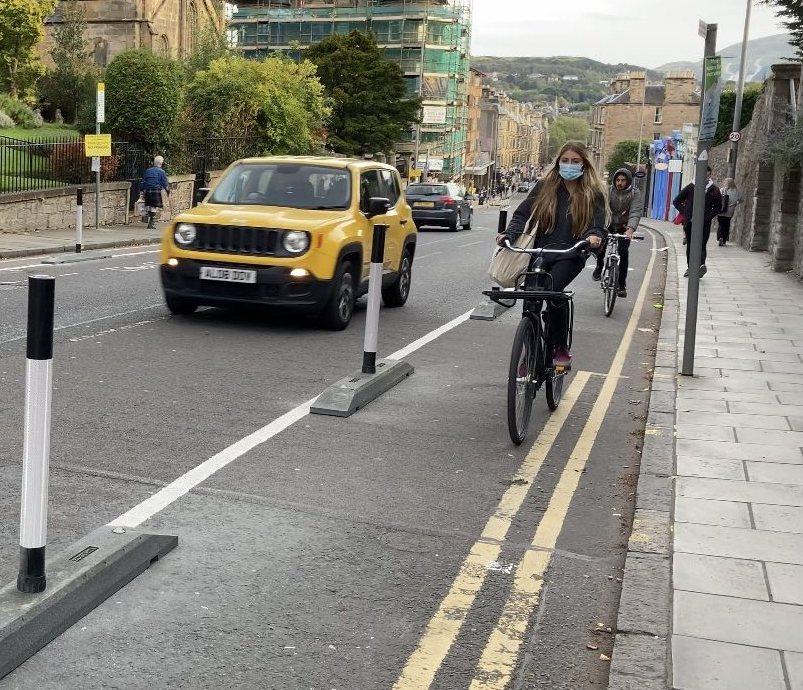
temporary cycle lane 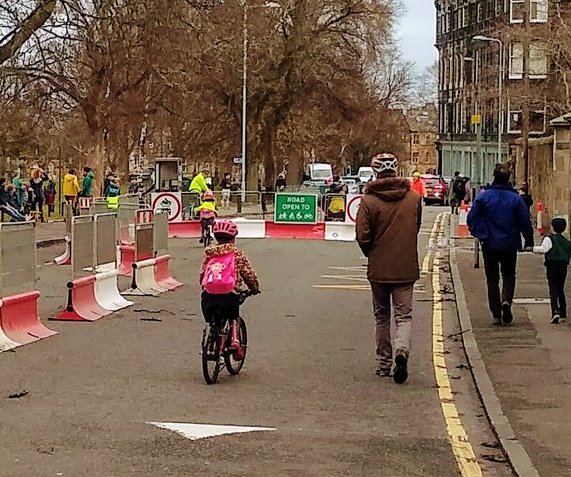
road closure on school route
- Council officers, Transport Scotland and private transport consultancies have for years been geared to a ‘car is king’ mentality. Whilst that has begun to change in recent years, particularly in Councils such as Edinburgh and Glasgow, a huge effort of training and political leadership will be required across Scotland to bring about a widespread culture change and the skills to ensure that the Transport Hierarchy becomes an accepted reality and that the AT cash will be used and effectively used.
2. Reducing car-km 20% by 2030 [PfG, p98]
The target was adopted by the Scottish Government in December 2020, primarily for climate emergency reasons. However, if achieved there would be major benefits to many policy areas, not least active travel. Streets in towns and cities would become less noisy, polluted and congested, making it more pleasant and safer to walk, wheel or cycle. The trend of falling car use and rising active travel /public transport would change public expectations of how and where we get around. Motorised use of road space would fall, as hopefully would complaints about congestion by those who still drive, thus making roadspace reallocation easier both politically and practically.
The PfG states that we “must move beyond rhetoric and target setting to demonstrate the ambition the world needs.” Despite that, right from the announcement of this target [section 2(b) in this submission], we have doubted that the Scottish Government has understood the determination that will be needed to achieve it, and will not be prepared to take the steps necessary. Why do we doubt this?
- The example of the Scottish Government’s 2010 target that 10% of all trips should be by bike by 2020 is instructive. Ministers (even the First Minister) repeatedly highlighted and lauded the target as if it was grounded in reality, even when, with only 2 or 3 years remaining, the actual numbers had hardly changed. Ministers appeared throughout to believe that carrots alone would do the trick – and even the carrots, most of the time, were miserable wizened specimens offering no hope of nationwide change.
- The PfG promises a ‘routemap’ by the end of 2021 as to how the target will be met. This is welcome, absolutely vital, and something which was never done for the above cycle use target despite repeated urging from ourselves and others. Unfortunately, the traffic-reduction routemap was put off from end 2020 to end 2021 on the grounds that we had to see how traffic settled down post-pandemic. This allowed traffic to return to, and in some cases already exceed, pre-pandemic levels, rather than attempting to capture some of the benefits. Moreover the implicit message to the public is to get back to ‘normal’ in terms of travel, rather than the message that car travel must be constrained. Thus one of the 10 years to 2030 has already been wasted, traffic has risen, and public expectations of growing car use not addressed in the slightest. Furthermore, the routemap is to provide ‘options’ for action – which suggests further delay before action is taken.
- We fear that the routemap will rely too heavily on carrots… “our investment in transport decarbonisation and active travel, will help drive forward our commitment to reduce the use of cars.” Chris Stark, CEO of the UK Climate Change Committee, which provides official advice to the Scottish Government, has already told MSPs that the target is a really tough one, and “will not happen unless there is a combination of carrots and sticks” but that the Scottish Government’s transport proposals “are mainly carrots.“ More positively, the PfG does promise “an analysis of demand management options” – but we wait to see what they cover and what Ministers are willing to accept.
- As recently as 2019 the Scottish Government was predicting that car trips would rise by 25% by 2037, and miles driven by 37%.
- Astonishingly, given both the climate emergency and the fact of a Green/SNP agreement, the PfG [p99] continues all existing road building programmes, including the hugely costly dualling of the A9 and sections of the A96. Not only does this give the public an implicit message which contradicts the traffic reduction target, but in concrete terms it will mean increased traffic on these roads, making the target harder to achieve and leading to further impacts on the towns and cities connected by the expanded roads. Whilst the PfG does have a welcome commitment to not “normally” set up further new roads projects, the length of time needed to set up new projects means that none would in any case be likely to begin during the course of this parliament.
What you can do
- If you agree with our comments, please email or ask to speak to your MSPs. Find them here… www.parliament.scot/msps/current-and-previous-msps. Particularly important points to raise are…
- the need for urgent action to rationalise Traffic Orders (see 1 above and appendix 3); and
- the need for strong action in the promised traffic reduction ‘routemap’ (see 2 above).
- Retweet our tweet about this article.
Appendix 1 – Other PfG policies relating closely to active travel
In addition to the two critical policies discussed above, we welcome several other PfG policies which could contribute to active travel and reduced car use. Again political courage and detailed attention, together with effective public engagement, will be required in order to achieve the best possible practical outcomes.
- [p98] school travel “aim of ensuring every child who lives within two miles of school is able to walk or wheel safely” A great ambition, which is likely to require significant motor traffic restrictions on streets near many schools.
- [p98] 20mph “all appropriate roads in built‑up areas to have a safer speed limit of 20 mph by 2025.” Note that in the previous Parliament the SNP government at a late stage blocked Green MSP Mark Ruskell‘s Bill for a 20mph default speed limit in all urban areas. This new policy in the PfG seems to move in that direction, so may be a useful outcome of the SNP/Green agreement – though it doesn’t sound quite as comprehensive as was Mark Ruskell’s Bill
- [p98] LEZs “low emission zones in four of Scotland’s cities by the end of May 2022″ Restating an existing welcome policy – although the zone plans are being criticised as too small and with insufficiently tough rules
- [p98] Transport policy “review of transport governance to align with climate and traffic reduction targets and deliver our active travel goals” This may sound a bit nerdy but is crucial – all aspects of transport policy need to work together to achieve these targets and goals, particularly the climate emergency. It will take political courage to genuinely make this happen
- [p59] Transport policy again “A green, sustainable and active transport system, with climate action and reducing inequality as core priorities”
- [p96] 20-minute neighbourhoods “places where people can have their needs met locally within a 20‑minute walk from their homes” A great ambition, but no clarity of whether it means just a few pilot areas, widespread adoptionm or something in-between. However “Our fourth National Planning Framework will ensure that all future planning decisions support meeting this ambition”
- [p97] Town Centres “Place-Based Investment programme, backed with £325 million over the next five years” to “revitalise town centres, provide new space for local businesses and jobs, and support the resilience and wellbeing of communities”
- [p83] Local business “£10 million multi‑year Scotland Loves Local Fund to support local people, businesses and community partnerships” Introducing this section, the PfG says “Local businesses have been challenged in competing with larger, out of town and online businesses.” However, despite that concern, and despite appeals by Edinburgh and Glasgow Councils and many organisations including ourselves, the Scottish Government rejected the opportunity to place a car-spaces levy on out-of-town car-based shopping outlets when they legislated for the Workplace Parking Levy (the WPL is welcome, but however applies mainly in-town). The PfG fails to correct this effective subsidy to out-of-town car-based shopping.
Appendix 2 – How the new government cash will be used [PfG p97-98]
The PfG gives little indication how the very substantial new levels of cash will be used. We imagine (and hope) that the bulk will go into high quality infrastructure. However, the PfG does say (without giving cash amounts) that some of the areas to be funded will be…
- A Cycling Framework for Active Travel – to be published in 2022. Given the new cash, the climate emergency and the new emphasis on AT, a new policy document is important
- Increasing the Cycling, Walking and Safer Routes grant for active travel infrastructure on local roads The CWSS grant (which goes to every Council on a population basis) has been the only guaranteed source of AT cash for councils, since it was introduced way back in 2001 by former Transport Minister (and Spokes member) Sarah Boyack. Depending on the size of this increase, it may give all Councils a much more substantial base AT budget, though there will still be a need for big government grants for major projects as in Sustrans Scotland’s current Places for Everyone scheme.
- An active freeway network for Scotland, comprising local networks within towns and cities and connecting settlements and major destinations with high quality, safe routes. Previously only a severely inadequate £50m over 5 years had been allocated for this ambitious and vital project. Hopefully it will now be funded sufficiently to start making a real difference.
- Maintaining the Scotland Cycle Repair Scheme, helping get old bikes out of storage and back onto our roads, as well as keeping well‑used bikes pedalling smoothly and safely
- Investment in the Sustrans 30 year National Cycle Network Plan
- Free bikes for school age children who cannot afford one – pilot schemes followed by national rollout.
Appendix 3 – Traffic Orders craziness, the Edinburgh example
The AT project delays, administrative burdens, costs and public confusion caused in Edinburgh by the dysfunctional Scottish Government Traffic Order regulations cannot be underestimated…
- The Council’s flagship West-East city-centre segregated cycleroute was delayed by some 3 years, and cut back, as a result of a small number of objections, all of which were eventually dismissed by the government. The Traffic Order rules required the objections to be referred to the Scottish Government – who took literally two years (see letter below) to come to a decision. As a result, costs increased and so cuts to the project became necessary – resulting in further consultation and delay.
- The council in 2020 installed a Spaces for People cycleroute on George IV Bridge, and this was very well used. However, there are also long term plans for a Meadows – George Street AT route along George IV Bridge, of a very different design, and with construction due to start at some point in 2022. The Traffic Order for this permanent scheme has to be issued for consultation shortly. However, the rules will not allow the Temporary Order for the existing scheme to remain until the new scheme is ready to construct and will not enable any other Order for the current scheme whilst the Order for the new scheme is being progressed. Hence the well-used SfP scheme has now been removed, leaving no cyclist protection until the new scheme is in place.
- The existing Spaces for People schemes are legal under TTROs (temporary traffic regulation orders, TROs). Many schemes have been successful and the Council wishes to make these permanent (some schemes being major, others quite minor). Around 50 of the schemes require Traffic Orders. However, the TTROs are likely to expire months before the legal processes for TROs can be completed (or longer if the TROs attract objections). The Council’s only legal option (other than removing then later replacing the schemes) is to move the schemes from TTROs to ETROs (experimental orders) followed by TROs. This will mean that, in addition to the consultations already held, the council will legally be forced to conduct two further full consultations for each of the 50 schemes (one for the ETRO and then subsequently for the TRO). The administrative burden on the Council is ludicrous and the public will understandably be confused, in some cases angry, and certainly blaming the Council.
Under English Traffic Order rules most of the above problems would not exist. The Scottish Government’s failure to expedite its promised improvements in Scotland’s rules is hugely disappointing – especially as the Cabinet Secretary has frequently said he would like to see successful SfP schemes become permanent!
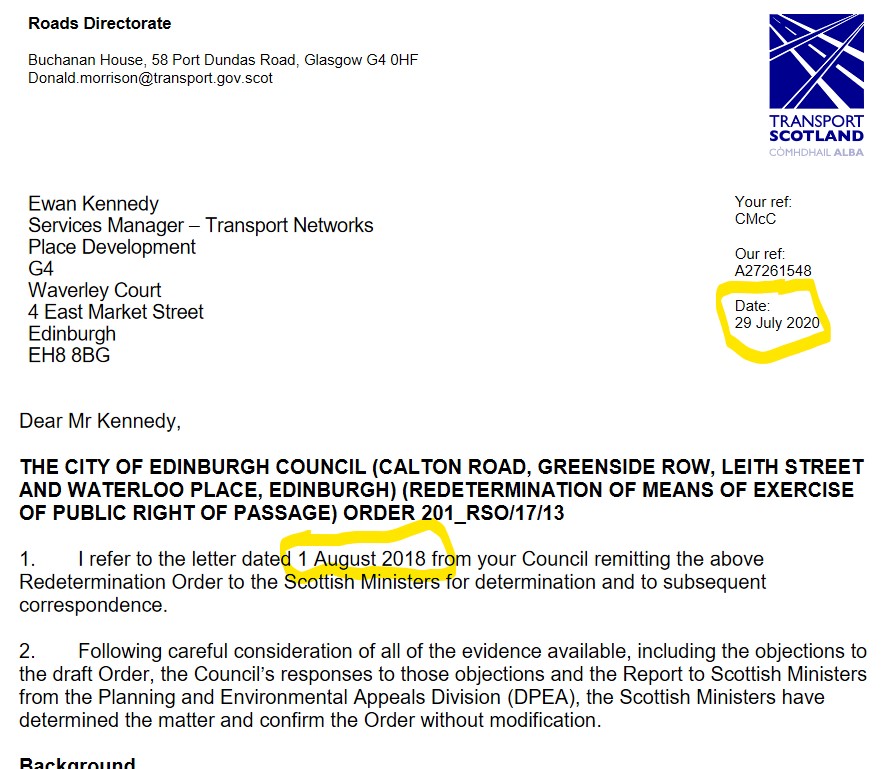
Scottish Government takes two years to come to a decision on objections to this west-east cycleroute Redetermination Order, eventually passing the Order without any changes, i.e. dismissing the objections. In England Redetermination Orders do not even exist and the decisions on such local matters can be taken by the local council. There was also a parallel TRO, which took almost as long, and with only one very minor modification needed.

